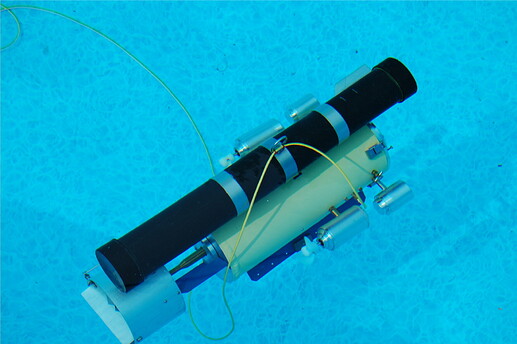Are brushless motors inefficient?
My ROV uses brushed motors in a sealed pods driving an open propeller. It was pure guesswork but works well and drives my ROV quite fast at 24v and 3 amps max. per motor.
I was thinking of switching to the T200 thruster and bought one. It is impressive but I don’t think it will match my home made one for the same power. I am probably wrong but without setting up a test to make a comparison (a big job) I just don’t know.
Does anyone have any real experience?
What is the approximate current of the T200 when moving at a steady (walking) pace in one direction?
My two side thrusters are not even in shrouds. The stern one is shrouded because of the rudder and elevator mounting.
I can’t understand how a battery can supply 10 amps to several thrusters at once for any length of time.
30 amps from an 18AH battery would only last 15 minutes I would guess before it tripped on temperature.
Maybe the BlueRov only draws a couple of amps per motor. However the standby current is 0.7 amps without any movement.
I will have to run the tests myself. I was hoping for answers here.
Hi @Rov36,
No - if anything they’re generally more efficient than equivalent brushed motors, because they don’t have friction from the brush. That comes with reduced wear and longer lifetimes, at the cost of a motor that’s harder to manufacture (so more expensive) and more complex to control.
If you’re interested in a bit more detail, this article was one of the first results from a search of “efficiency of brushless vs brushed motors”.
A thruster produces a pressure differential. How fast water flows through it depends on
- the rotation rate the motor controller is aiming for
- other forces on the system (e.g. from water currents, and other thrusters)
How fast the thruster itself ends up moving depends on
- the water flow rate through the thruster
- the weight and drag characteristics of what the thruster is attached to
- the orientation of the thruster relative to the existing system motion and its lower drag directions
Our thruster product pages (T200, T500) include a Technical Details section, where you’ll find current draw maxima and a variety of plots, including a plot of power usage vs (static) thrust. There’s some discussion of thrust at speed in this thread.
Our Lithium-ion battery is rated to 60A continuous output, subject to temperature constraints. Cool water and a metal enclosure can help with keeping the battery cool enough.
Current usage depends on how hard the motors are being driven. Runtime depends on battery capacity and current usage. For example, if your vehicle usage is mostly extended periods of high throttle then that’s not how an ROV is generally expected to be operated, so you’ll need to determine/measure your own runtime estimates rather than using the ones in our BlueROV2 technical details.
I am setting up some tests to compare my brushed home-made thruster to the T200. I expect the T200 to be much better. However my ROV moves quite fast with about 6 amp total draw from 24V from an inverter. It is difficult to compare because my ROV is torpedo shaped. I am doing the tests before changing all 3 of my thrusters to T200s. For anyone unaware my side thrusters rotate over 180 degrees and there is a rudder and elevator behind the rear thruster. The black tube is a negative keel. Thanks for the tip on the battery, I may have to upgrade mine.
A Chinese “2.1kg KV860 Motor for ROV” Thruster (left), the BlueRobotics T200 (right), and my Homemade Side thruster (next picture), were tested in a large tub of water. As the tub was filled it’s sides bulged out and, even though a pipe clamp was placed across the top, it could not be filled as high as desirable. Because it really was not big enough nor deep enough the shrouded thrusters tended to suck air from the surface. However, all thrusters were tested under the same conditions, so the results are meaningful.
A T arm was made with the thrusters mounted at the bottom of the vertical aluminum arm. The horizontal wooden beam is balanced and presses down on a rubber grommet, at a marked distance, on a scale. The lever is 1:1 and the scale can be moved to the other end for reverse thrust measurements.
The Brushless Thrusters were powered from the same BlueRobotics ESC to minimize errors.
Note the bucket was removed and the tub filled before the test. The power supply and pulse generator were also different.


Conclusion
• The Chinese thruster took on average 2.8 times the power of the T200 for the same thrust. They may save money but would use almost three times the power of the T200 and may fail much faster than the T200s
• My Side Thruster took on average 1.5 times the power of the T200 for the same thrust. It has the disadvantage that it could leak, and the lip seal will have more friction losses the deeper it goes. It is also more likely to get fouled, is bigger and heavier, and is complicated to make and repair.
• My Side Thruster design is susceptible to corrosion unless the aluminum is treated.
• The T200 can be damaged by sand but it seems the newer models have been improved.
• The T200 is more powerful than my design.
• It makes sense to replace my Side Thrusters with T200s.
My rotating design is fine for shallow dives but there is a problem going deep. The pressure tries to push the shaft into the ROV and at some depth the simple thrust washer will jam the motor. I am opening another thread to discus this issue. It is called Rotating Shaft Seals


